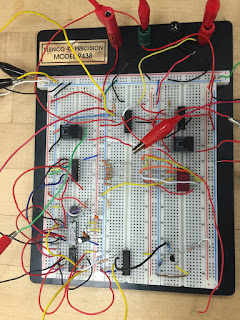(Upload soon)
2. Explain your setup.
The transition of my circuit of the previous Rube goldberg circuit will lift a hoist off of a photo-sensor. The photo-sensor is used as one of the two resistors in the non-inverting amplifier. The voltages are close enough that once the photo sensor is given light that it then produces a high enough gain that it switched the relay. The two outputs of the relay are connected to a diode, that is lit to show the relay hasn't switched yet. Once the relay is switched the rest of the circuit is activated. First the 7 segment display counter is activated and is counted from 1 to 9 and the motor will spin from 4 to 9. There will be a 555 timer, 74192, xor gate, and 7447 decimal counter. The motor will spin lifting the gate which releases the ball. As the ball falls, there a switch at the bottom which is activated when the ball hits it. When that switch is tripped it will activate another motor dropping another ball which will hit a switch on mine and also hit another switch which activates the next circuit.
3. Provide photos of the circuit and setup.
4. Provide at least 2 new videos of your setup in action, one being a failed attempt.
(Videos will be uploaded later)
5. What failures did you have? How did you overcome them?
A failure that I had to overcome was trying to find the right resistors for the photocell when exposing it to light. At first, we couldn't find a good enough cover for resistor, but then when adjusted the resistors it worked correctly.
6. Group task: Explain your group RG setup.
Austins circuit will trigger mine by blowing a paper off of my photocell, which causes my relay to switch. At the end of mine a ball will fall down a ramp running into Mohamed's lamp cause it to turn on which activates his.
7. Group task: Video of a test run of your group RG.



















